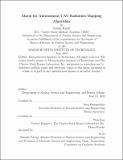| dc.contributor.advisor | Danagoulian, Areg | |
| dc.contributor.author | Knoll, Justin | |
| dc.date.accessioned | 2022-08-29T16:02:38Z | |
| dc.date.available | 2022-08-29T16:02:38Z | |
| dc.date.issued | 2022-05 | |
| dc.date.submitted | 2022-06-17T16:07:23.269Z | |
| dc.identifier.uri | https://hdl.handle.net/1721.1/144656 | |
| dc.description.abstract | The purpose of this research is to create an alarm threshold algorithm for use in an autonomous unmanned aerial vehicle (UAV) for radiation mapping purposes in the event of a nuclear disaster or use of nuclear weapons. Information from this alarm could feed into real time decision making on the UAV system, so the alarm is based on data from 1 second collection windows. All data collection was done with a Cs₂LiLa(Br,Cl)₆ detector. The testing included both laboratory experiments and full scale flight testing with the UAV system. Several alarm methods were devised and tested, attempting to take advantage of assumptions about the isotopes that would be present in a nuclear disaster and the known properties and gamma ray energies of these isotopes. Most data collection used either ¹³⁷Cs or ⁶⁰Co sources. Receiver operating characteristic (ROC) curve analysis demonstrated that alarm methods setting a threshold on narrower energy bins were less sensitive than methods using the full spectrum count rate, while the most sensitive method was to use bins containing all spectrum data up to the full peak energy of the isotopes of interest but ignoring higher energies. Similar ROC curve results were found with a simulated ¹³¹I source, indicating this method would also work with other isotopes. This method was then testing with lab and flight test data using a three standard deviation threshold. The median false alarm rate in the background flights was 0.19%, and sources could be successfully detected at high rates from relatively long distances. For example in one flight a 90% detection probability was attained for an 8 mCi cesium source from a total distance of 22±2 m. The probabilities of finding anomalous sources of radiation and false alarm appear to be sufficient based on the observed data, and this method had the best performing ROC curve of those tested. | |
| dc.publisher | Massachusetts Institute of Technology | |
| dc.rights | In Copyright - Educational Use Permitted | |
| dc.rights | Copyright MIT | |
| dc.rights.uri | http://rightsstatements.org/page/InC-EDU/1.0/ | |
| dc.title | Alarm for Autonomous UAV Radiation Mapping Algorithm | |
| dc.type | Thesis | |
| dc.description.degree | S.M. | |
| dc.contributor.department | Massachusetts Institute of Technology. Department of Nuclear Science and Engineering | |
| mit.thesis.degree | Master | |
| thesis.degree.name | Master of Science in Nuclear Science and Engineering | |
